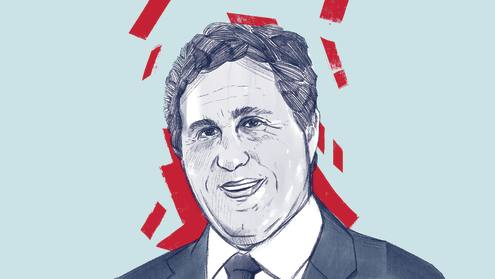Disgraced cryptocurrency entrepreneur Sam Bankman-Fried was convicted in his fraud trial at the beginning of November. A jury in New York found him guilty on seven counts. The sentencing will not be decided until March next year, but he could face a sentence of more than 100 years in prison.
After graduating from university, Mr Bankman-Fried worked as a cryptocurrency trader at the brokerage firm Jane Street. He made a fortune by betting on bitcoin price differences on exchanges in the US and Asia. In 2017, he set up his own brokerage firm, Alameda Research, and in 2019 he founded the crypto exchange FTX. Its collapse at the end of 2022 shook the crypto industry in a huge scandal that destroyed a lot of trust.
During my work on the Markets in Crypto-Assets Regulation (MiCA), I was often asked whether a case like Mr Bankman-Fried’s would have happened under the law. My answer is: most likely not. This is exactly why this EU regulation is so important, and why I would like to explain it.
To address the intriguing question of whether Europe is evolving into Crypto Valley, the answer is a nuanced “maybe”. The region has the potential, but the realisation depends on collective (and your) efforts.
Europe’s pioneering legal framework
The EU has meticulously laid the legal groundwork for this evolution. In understanding that money is built on trust and recognising that crypto is a manifestation of trust, European policy-makers have diligently crafted a framework. MiCA stands as a testament to this effort, providing a solid foundation for the crypto landscape. The regulation creates legal certainty for innovation in the distributed ledger sector.
But it was a long process. After rigorous negotiations spanning nearly two-and-a-half years within the Committee on Economic and Monetary Affairs in the European Parliament, where I was the rapporteur for MiCA, a political agreement was reached on June 30, 2022. Following trilogue negotiations between the European Parliament, the European Commission (EC) and the European Council, the agreement was adopted by the committee in October 2022 and by the plenary in April 2023. MiCA is now in force, but a majority of the regulation will not take effect until the beginning of 2025.
Read more
MiCA represents a binding regulation applicable in all member states without the need for national transposition. The forward-looking nature of MiCA ensures that it cannot be applied retroactively. Existing crypto-assets admitted to trading before the regulation’s entry into force have a transition period of 36 months to comply, showcasing a thoughtful approach to industry adaptation. Additionally, crypto-asset service providers have an 18-month window to continue operations without a MiCA licence.
The coin classifications introduced by MiCA — e-money token, asset-referenced token, utility token and non-fungible token (NFT) — reflect the diversity of the crypto landscape, recognising the various functions these assets serve.
Crucial provisions in MiCA
Crucially, MiCA levels the playing field by aligning own-funds requirements for crypto issuers with the rules established for banks under the Capital Requirements Directive. This ‘same risks, same rules’ principle is embodied in Article 37 of MiCA, ensuring issuers of asset-referenced tokens maintain sufficient funds.
The authorisation process is a key aspect of MiCA and emphasises the importance of central banks in overseeing money. The European Central Bank (ECB) plays a pivotal role in ensuring the stability of the eurozone, and during the authorisation of new tokens, the ECB must provide a mandatory positive assessment to safeguard monetary stability.
Addressing the contentious issue of NFTs, MiCA excludes them from regulation, unless national competent authority EU member states classify them as financial instruments or utility tokens, potentially triggering European supervision under the Markets in Financial Instruments Directive.
Supervision architecture
The supervision architecture is carefully delineated, with significant asset-referenced tokens falling under the purview of the European Banking Authority and significant crypto-asset service providers supervised by the European Securities and Markets Authority.
Environmental safeguards, a point of contention during negotiations, are addressed through disclosure requirements on energy consumption and potential environmental impacts. A revision clause allows for monitoring and adjustments based on environmental effects.
In tackling anti-money laundering (AML), MiCA defers to the AML package of the EC, emphasising the commitment to combating money-laundering without duplicating regulatory efforts.
Is MiCA futureproof?
While MiCA represents a significant step forward, its futureproofing is acknowledged as an ongoing challenge. In a rapidly evolving technological landscape, a review clause ensures that MiCA’s relevance is periodically assessed and adjusted as needed.
In the constant development of technology, society and values, no legislation can be 100% futureproof. No one knows what the market will look like in 10 or even five years. That is why we tried not to go overboard with MiCA. We did not touch any assets that are already on the market today. Also, we believe we did not make the rules too tight: a dedicated review clause exists to check if this version of MiCA is still fit for purpose in the future.
MiCA marks a commendable stride in the right direction for Europe’s crypto landscape. While a global MiCA would have been optimal, the pioneering work accomplished by Europe is likely to set a precedent for global emulation. As calls and requests pour in from around the world, including South Korea, Japan, Israel and the US, MiCA stands as a testament to Europe’s leadership in shaping the future of crypto regulation.
As the global crypto ecosystem continues to evolve, Europe’s proactive approach through MiCA positions it as a potential Crypto Valley, ready to navigate the complexities of the digital financial frontier. The robust legal framework, forward-looking provisions and commitment to global collaboration make Europe a formidable player in the unfolding narrative of the crypto revolution. The journey towards becoming Crypto Valley is a dynamic one, and Europe is poised to be at the forefront of this transformative journey.
Your turn
With Europe’s groundbreaking MiCA regulation, the path to Crypto Valley is visible. Yet, the realisation of this vision relies on collective efforts, and here is where you come in.
By understanding and embracing these technologies, you become an active participant in the financial evolution. So seize the initiative — whether you are a tech enthusiast, an investor or simply curious — and engage with these innovations. With Europe leading the way, your participation can contribute to a global financial landscape that is inclusive, innovative and secure.
Stefan Berger is a German economist and politician of the Christian Democratic Union, who has been serving as a Member of the European Parliament since 2019.







